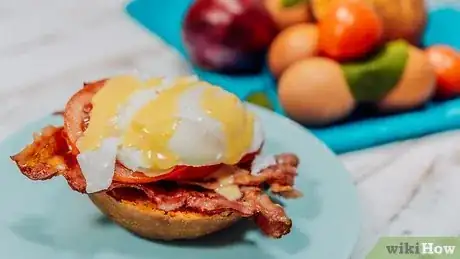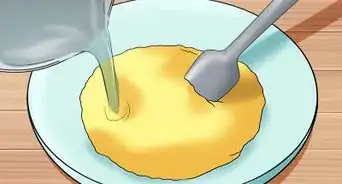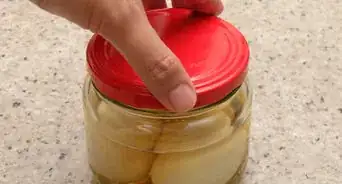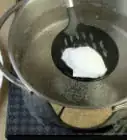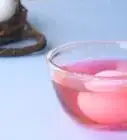This article was co-authored by wikiHow Staff. Our trained team of editors and researchers validate articles for accuracy and comprehensiveness. wikiHow's Content Management Team carefully monitors the work from our editorial staff to ensure that each article is backed by trusted research and meets our high quality standards.
The wikiHow Culinary Team also followed the article's instructions and verified that they work.
This article has been viewed 770,985 times.
Learn more...
Eggs Benedict is a classic at Sunday brunch, New Year's morning, or a morning with that special person in your life. The hollandaise sauce can make it or break it. Master that, and you will impress your family or guests with your culinary talent.
Ingredients
Makes 2 servings
-
For the Hollandaise Sauce:
- 4 egg yolks
- 1 tbsp (15mL) freshly squeezed lemon juice
- 1 stick (½ cup / 115g) unsalted butter, cut into small cubes
- Salt
- Cayenne pepper
-
For the Eggs Benedict:
- 4 slices Canadian bacon
- 2 English muffins, split
- 1 tsp (5mL) white vinegar (optional)
- 4 eggs
- Salt and pepper, to taste
- 3-4 sliced green olives with pimento or black olives
- Paprika for dusting
- Fresh parsley, for garnish
Steps
Making the Hollandaise
-
1Melt the butter. Heat the butter in a wide pan, until there are just a couple small pieces of butter left. Remove from heat so it cools while you move on to the next step.[1]
- If you're feeling extra fancy, clarify the butter by skimming off some or all of the milk solids. Their removal will make the sauce thicker, but less rich.[2] Alternatively, just let these sink to the bottom of the pan, and decide what to do with them when it comes time to pour.
-
2Set up a double boiler. If you don't have a double boiler, just fill a pan about a ⅓ full of water and heat until you see a couple thin streams of bubbles. Place a heat-safe metal or glass bowl snugly on top of the pan, without touching the water. This indirect heat reduces the risk of your sauce burning and separating.Advertisement
-
3Whisk egg yolks and lemon juice together. Add four egg yolks and 1 tbsp (15mL) lemon juice to the double boiler. Whisk constantly and vigorously until the mixture becomes frothy and lighter in color, and the whisk leaves trails in the mixture. [3] An experienced chef can achieve this in a minute or two, but 5–10 minutes is common for a first try.
- Scrape down the sides of the bowl occasionally as well. Any egg left sitting in place might scramble.
-
4Watch for signs of separating. If the egg mixture gets too hot, it will curdle or "split" into solids and liquid. If it starts to feel too hot or steams heavily, pick up the bowl with an oven mitt or towel. Whisk vigorously for 30 seconds to cool the eggs down, then return to heat.
-
5Add the butter gradually. Pour the butter in a small, steady stream, whisking constantly and vigorously. The sauce should thicken easily at first, then become more difficult to combine. Pour more slowly as this happens, since too much butter can cause the sauce to split.[6] This step can take anywhere from 2–5 minutes.
- Once you're more experienced, you can add the butter ladle by ladle, or even in two large batches. This risks splitting the sauce, but if you succeed you'll have a faster, airier hollandaise.
-
6Adjust the spices and liquids. Stir in salt and cayenne pepper to taste. You may also whisk in a little more lemon juice if you want a tangier flavor. If the sauce is thicker than you prefer, whisk in a little hot water.
-
7Keep in a warm place. Until you finish the other ingredients, cover the bowl and place in a warm spot. Cool temperatures may split the sauce.
- If the sauce gets too thick, whisk in a few drops of warm water before serving.
Making Eggs Benedict
-
1Fry Canadian bacon. Heat the Canadian bacon in a skillet over medium-high heat. Cook for a few minutes until it starts to brown, turning occasionally. Once ready, leave it in the skillet to keep it warm.
- English back bacon works as well.
-
2Toast the English muffins. Cut each English muffin in half and place them on a baking sheet, cut sides up. Butter the cut sides lightly and toast under the broiler until light brown.
-
3Bring water to a low simmer. Fill a wide nonstick skillet or shallow pan half full of water. Heat until there are a couple thin streams of bubbles, or until a thermometer reads 160–180ºF (71–82ºC).[7]
- Optionally, add 1 tsp (5mL) white vinegar to the water. This helps the egg white stay in position instead of separating throughout the water, but this can affect the texture and flavor.[8]
-
4Add the eggs. Crack one egg into a small bowl, taking care not to break the yolk. Gently lower the edge of the bowl into the water, letting some water flow into the bowl. Tip the bowl to slide the egg slide into the water. Quickly repeat with remaining eggs.
- If the water has reached a full simmer, "spin" the water once with a spoon to cool it down before adding the egg. Do not do this once an egg is already in the water.
- If the pan is small, only cook two or three eggs at a time. Eggs that crowd against each other may merge into once mass.
-
5Poach the eggs. Cook for 3½ minutes until the egg white is set but the yolk remains soft. Remove with a slotted spoon, allowing the egg to drain.
-
6Put it all together. Place one or two muffin halves on each plate. Lay a slice of bacon on top of each muffin half, followed by a poached egg. Spoon Hollandaise sauce generously over the eggs. If you would like, you can top the dish with a dusting of paprika or some olive slices. Garnish the plate with parsley on the side.
Variations
-
1Make vegetarian Eggs Florentine. Instead of the bacon, sauté spinach until it wilts, then place that on top of the English muffin. You'll need about 4 cups (960mL) raw spinach for this recipe.
-
2Serve with asparagus. Steamed asparagus pairs perfectly with hollandaise sauce. Serve it on the side and drizzle the sauce over the entire plate. Sprinkle with finely chopped basil for more summer flavor.
-
3Use American bacon and tomatoes. "Eggs Blackstone" uses crisp, fatty American bacon (streaky bacon) instead of Canadian bacon. Pair this with a slice of raw, juicy tomato between the muffin and the bacon.
-
4Replace the meat with smoked salmon. The lemon flavor works wonders with seafood. Complement the salmon even more with a finely chopped handful of dill, mixed into the finished hollandaise sauce.
-
5Finished.
Community Q&A
-
QuestionWhere do I add the olives?
 Community AnswerOlives are optional. If you want to use them, put them on top of the hollandaise sauce when you put the eggs benedict together.
Community AnswerOlives are optional. If you want to use them, put them on top of the hollandaise sauce when you put the eggs benedict together. -
QuestionMy sauce curdled. What did I do wrong? (It tasted good, but it wasn't pretty.)
 Community AnswerIt probably got too hot. Maybe next time, if it shows signs of curdling, take it off the heat and stir it for 30 seconds to cool it, then put it back on.
Community AnswerIt probably got too hot. Maybe next time, if it shows signs of curdling, take it off the heat and stir it for 30 seconds to cool it, then put it back on. -
QuestionWhat can I use if I don't have any English muffins?
 OllieoxenfreeCommunity AnswerToast.
OllieoxenfreeCommunity AnswerToast.
Things You'll Need
- Double boiler or pan and heat-safe bowl
- Whisk
- Skillet
- Shallow, wide pan or deep, wide skillet
Warnings
- When making the Hollandaise sauce do not let the eggs get too hot or you will end up with scrambled eggs.⧼thumbs_response⧽
References
- ↑ http://www.reluctantgourmet.com/hollandaise-sauce/
- ↑ http://www.theguardian.com/lifeandstyle/wordofmouth/2011/may/05/make-perfect-hollandaise-sauce
- ↑ http://www.smartkitchen.com/exercise/print/hollandaise-sauce
- ↑ http://www.smartkitchen.com/exercise/print/hollandaise-sauce
- ↑ http://www.bbcgoodfood.com/recipes/2438/basic-hollandaise
- ↑ http://www.reluctantgourmet.com/hollandaise-sauce/
- ↑ http://whatscookingamerica.net/Eggs/PoachEgg.htm
- ↑ http://whatscookingamerica.net/Eggs/PoachEgg.htm
- ↑ http://www.reluctantgourmet.com/hollandaise-sauce/
About This Article
To make eggs Benedict, start by making the Hollandaise sauce, then cover it and keep it warm while you make the rest of the dish. Next, heat the Canadian bacon in a skillet until it starts to brown, then turn off the heat and leave it in the skillet to keep it warm. Lastly, toast the English muffins and poach your eggs. To put it all together, place 1-2 muffin halves on each plate, lay a slice of bacon on top, then add a poached egg. Spoon Hollandaise sauce over the eggs, top with a dusting of paprika, and enjoy! If you want to learn how to incorporate different meats into your eggs benedict, keep reading the article!
